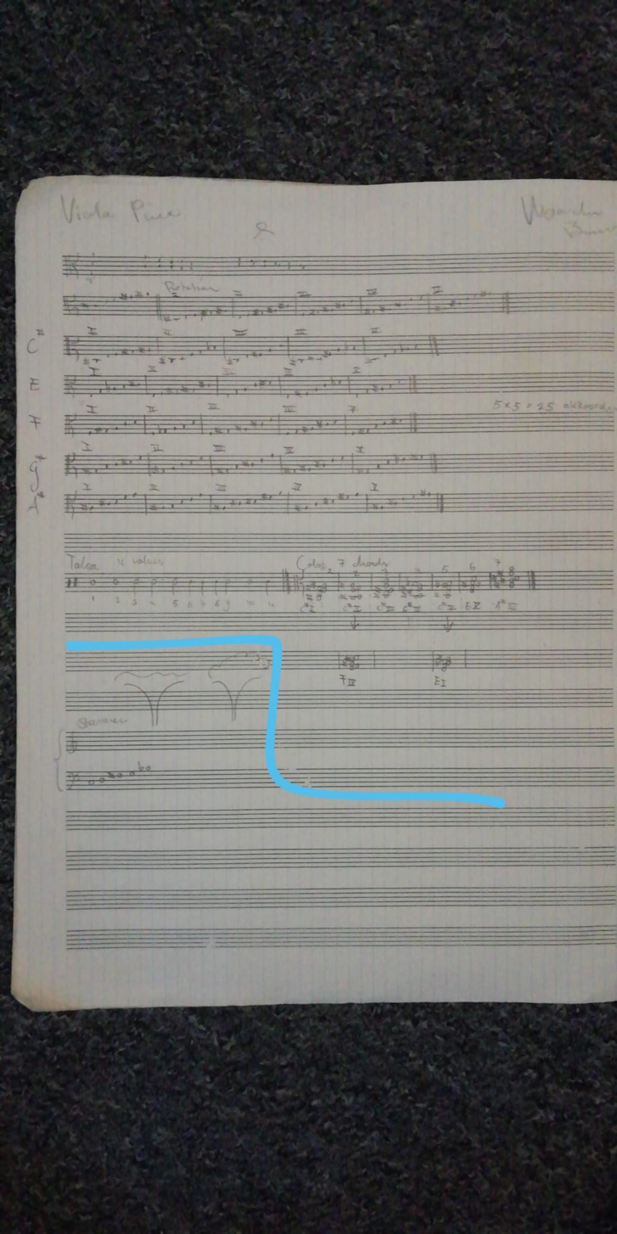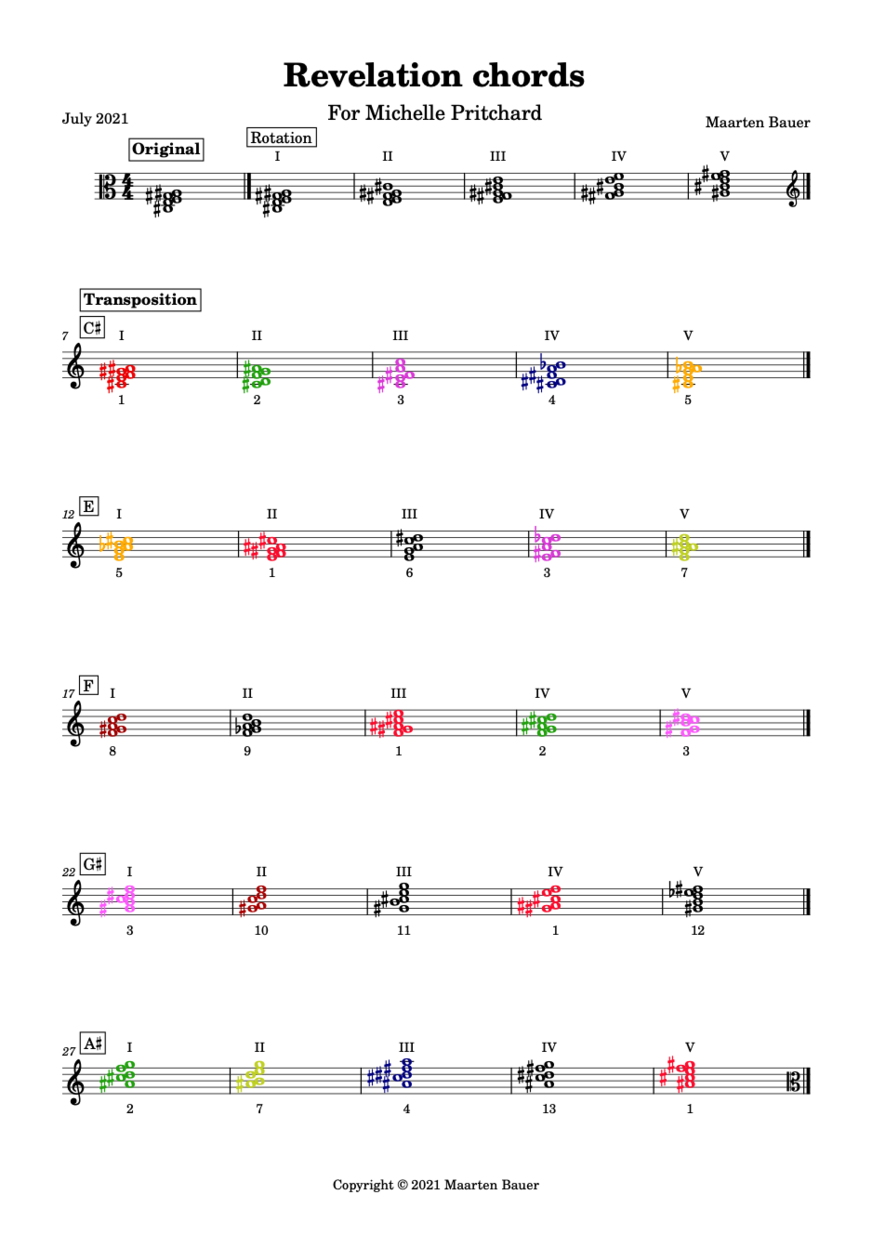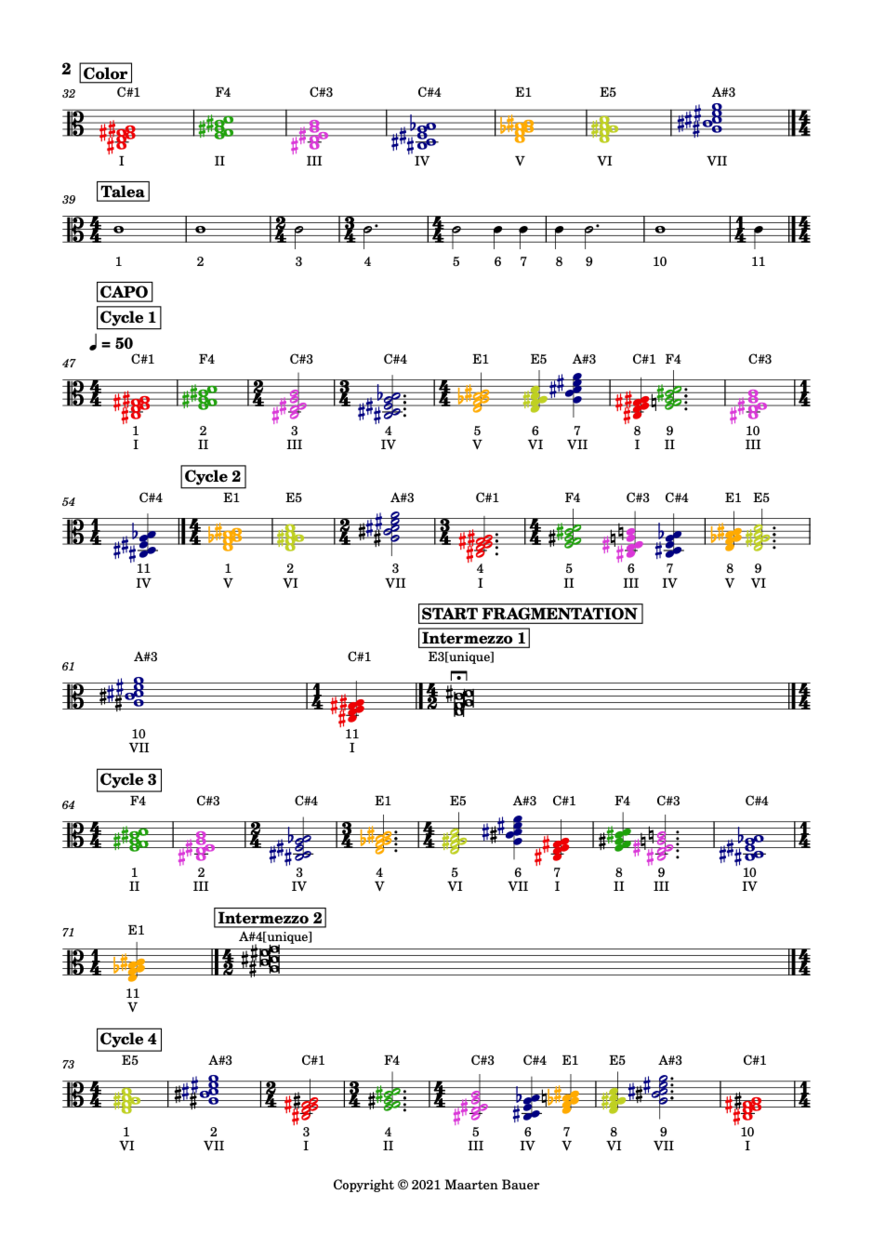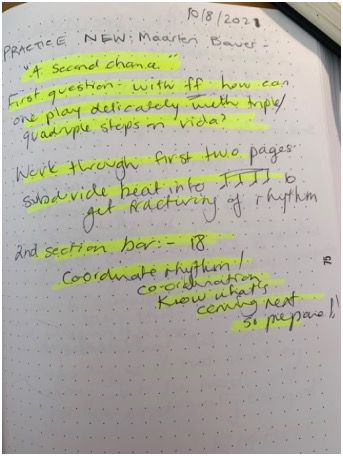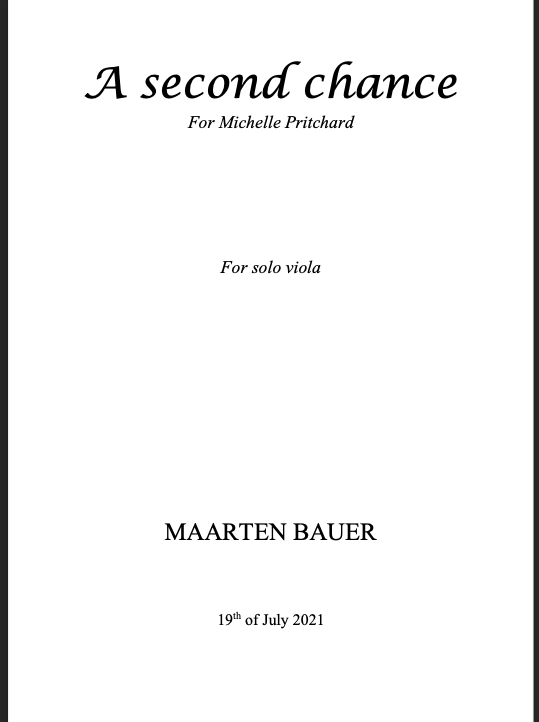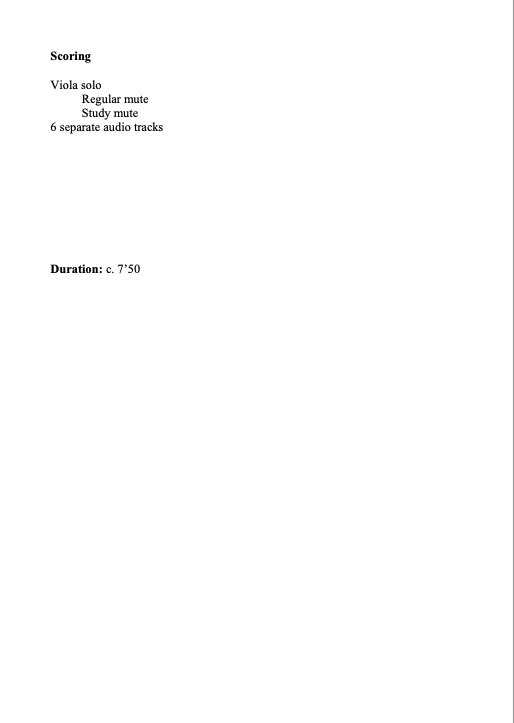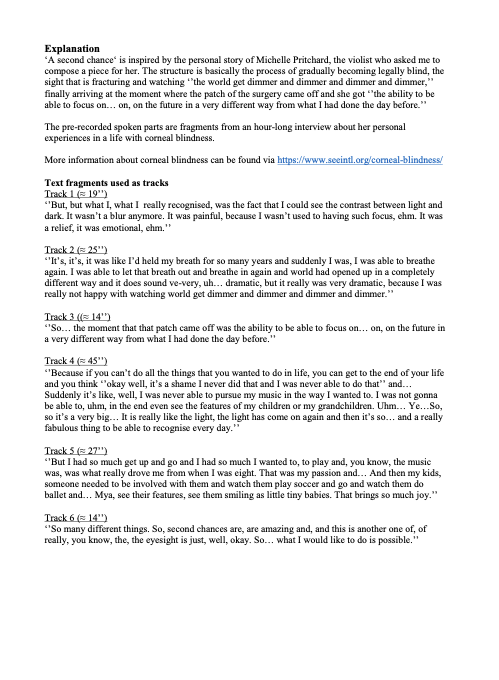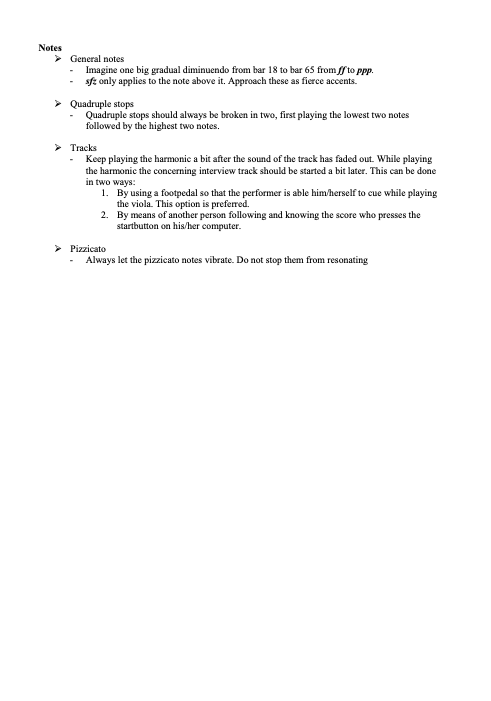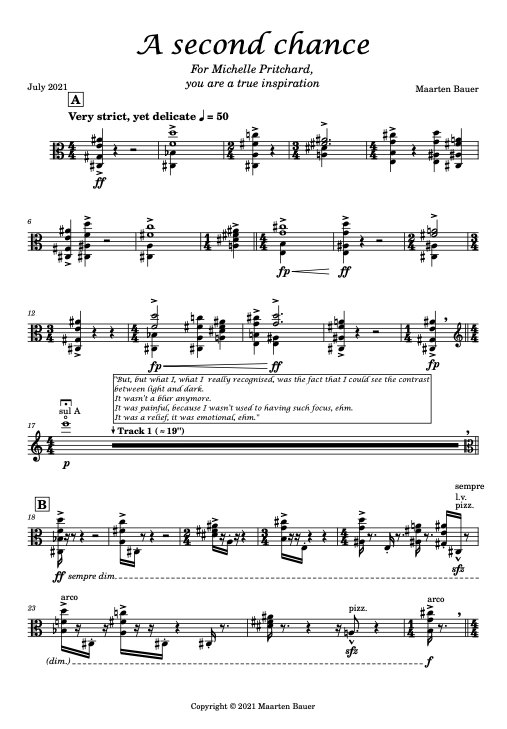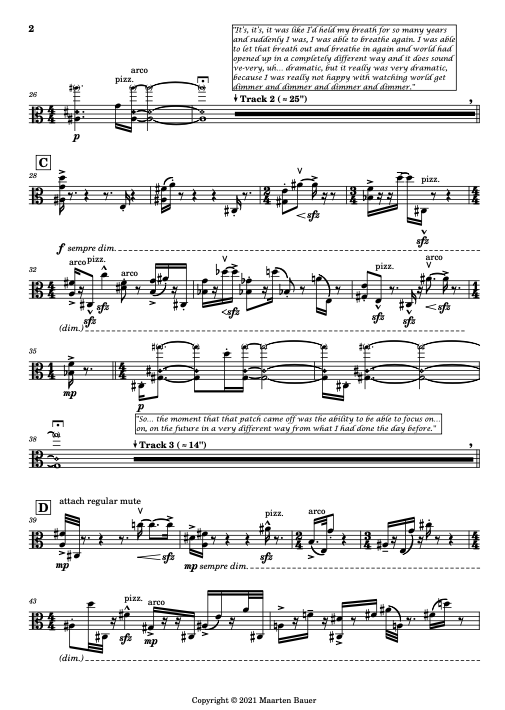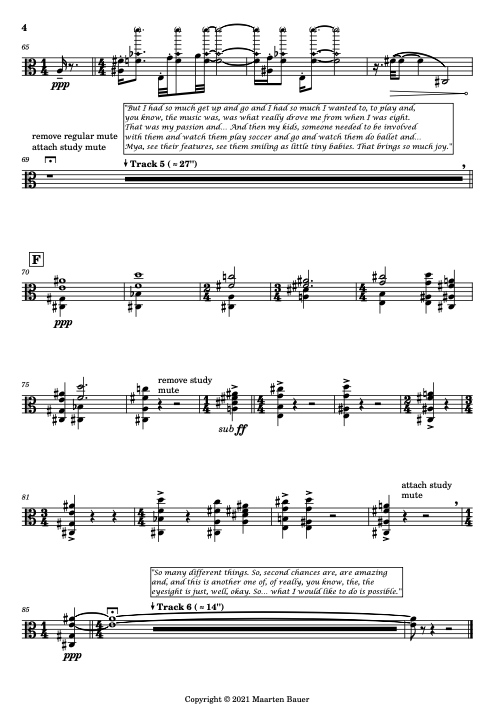Maarten Bauer- Case Study 1
1. Initial contact
Our initial contact was made as a result of the email I sent through to Martijn Padding, head of the Composition Department at The Royal Conservatoire in The Hague.
Bauer was in his third year of his Bachelor studies in Composition.
2. Background of the composer
Bauer (2000) is a Dutch composer, musician (saxophone and voice) and teacher. In the Conservatoire he studied under Martijn Padding, Calliope Tsoupaki, Yannis Kyriakides and Cornelis de Bondt. Bauer connects western classical music with other world music traditions, in particular Indonesian traditional music.
He describes himself as a conventional composer to whom classical musicians can relate. He focuses on getting to know the musician when composing for them.
Originally a saxophonist, recognising the limited repertoire for the classical saxophone he started his compositional journey by arranging music for himself to broaden his experience on the instrument.
Since that time, Bauer has collaborated with ensembles and orchestras such as the Residentie Orkest, Nederlands Blazers Ensemble and Kluster 5 to name a few.
There is more information available on his Website.
Some of the music he shared with me earlier on in the collaboration was Wolfgang Rhim’s: Stabat Mater and David Maslanka Concerto for Sax and Winds.
3. Timeframe
Start of collaboration March 2021- ongoing.
Copyright, Weston Contact Lens 2021https://www.westoncontactlens.com/wp-content/uploads/203200061_59258f03ee-1.jpg
4. COMPOSITION CONCEPT: NEW WORK
4.1. In our initial meeting via Zoom on the 9th March, 2021, Bauer described himself as a
"Conventional Composer with whom classical musicians can relate" and
"I don't think of limits, I only think of the performer"
With regards to extended techniques,
"Stick to your own technique, don't see them as extended techniques"
We discussed the possibilities of the composition encapsulating multiple roles- perhaps as a Solo and involving another device. Bauer agreed to write a five to seven minute work with the viola in a prominent role, either for solo, duo or trio. I discussed the possibility of exploring extended techniques and the hopes for a melody line.
The collaboration with Bauer was unique in the way that the process began with him interviewing me about my experience of becoming legally blind as a result of the degenerative corneal disease Keratoconus. I felt comfortable sharing my journey with him, inspired by his openness of sharing a moving audio visual clip of himself that was released on YouTube, ‘Actually, you are quite handsome’.
8/7/2021 Meeting with Maarten re composition. (With AudioTranscription of parts of the interview he conducted with me).
Composition takes form- it is formed around the gradual loss of sight as encapsulated in the recorded segments of an interview.
The contrast between light and dark. Voice and instrument.
Silence is important. Talks a bit about Javanese culture “Wayang Kulit” Indonesian Shadow theatre.
It was in this meeting I suggested the idea of using mutes, orchestral mutes and practice mutes. He took to this idea and this was then included in his compostion.
Bauer talks about the Dutch word ‘afbrokkelen’ and ‘verbrokelen’- “Cracking” “Crumbling”- representations of what Keratoconics see. The fracturing of light and images.
Once he had decided to write his composition based on my experience I directed him to several websites and sent links to pictures on the internet that give an impression of what it is ‘looks like’ from a Keratoconic’s perspective.
This is one of the photos I shared:
Maarten Bauer, voice recording.
Post interview with Maarten, His ideas through a recording on Whatsapp.
30th June. 2021. Thinking of two layers. Voice and music.
This resulted in a very different role for me in the collaborative process. Bauer did background research to gain a better understanding of Keratoconus and asked about my own personal experience.
Below a slide show of early sketches shared with me so I could understand how he was shaping the piece and the chords.
Bauer stated that in the relation to the music,
“I don’t want to put any emotion in it because the way that you talk is so honest that anything I will do or fill in will sound fake.”
He showed the interview to his teacher Yannis Kyriakides to discuss his thoughts,
and how to best utilise the recording.
I interviewed Bauer in Middelburg after the completion of the piece. This interview was helpful in understanding his musical roots, how he composes and why. This included a lunch party and I was able to meet his parents
We had a series of workshops, one soon after the completion of the music.
5. My Roles
5.1 Initiator of collaboration
I initited this collaboration
5.2 Role as Violist
‘A Second Chance’ is written for viola and recorded voice.
I play an integral role as it is a composition about my own journey losing my sight.
I am both the violist - performer and the recorded voice in the composition.
5.3 Role as Communicator
I have performed the role of communicator with and without my instrument in hand. Through interviews, workshops, emails, messages on social media, phone calls and dinner parties. Workshops are the most engaging way to collaborate, here you have both the benfit of the instrument and you can discuss issues, ideas. Fortunately, this was two-way communcation.
5.4 Role as Interpreter
Understanding what is written in the score; transmitting the story, not only through my physical being, through my voice as recorded in the interview and then channeling this through my viola to the listener. This is evident through the workshops and the synopsis of the work I have included in my research.
5.5 Role as Promoter (into the future).
As violist and performer, I am hoping I will be able to play Bauer’s composition, not just in my final recital but also in the future to raise awareness for Keratoconus and provide hope that this disease does not have to mean an end to our dreams and our passions.
As an ambassador in Australia, I play an active role in raising awareness and providing support through KeraClub, Keratoconus Australia and the Save Sight Foundation.
I feel the results of this collaboration will move audiences.
Bauer’s music will also be introduced to Australia as a result, and hopefully the wider world.
6. My Responsibilities
6.1 Before making initial contact, ensure that I resonate with the composers’s style of writing.
Maarten sent me links to his website and You Tube links as well as a score of his work ‘Alone, Lonely One’ for solo viola and 6 singers. This
Not only had he written with the viola in a prominent role, but I was very taken with his style of writing and emotional engagement.
6.2 Organise an initial meeting to make sure you are able to not only resonate with the composer’s music but also the composer himself.
This was first conducted through a Zoom meeting due to our timetables not matching up. He is based in The Hague and I was in Middelburg except for once a week attendance at lessons and rehearsals at The Royal Conservatoire in The Hague.
His enthusiasm, honesty, integrity and professional approach gave me confidence that this project would work.
6.3 Give clear guidelines for time
Time frames were discussed in the first meeting in order to ascertain if this was a possibility for both composer and performer. September 2021 was decided upon as being a realistic completion date for the composition.
I also suggested this would be performed in my Final Master 2 Recital.
6.4 Discuss ideas with the composer.
Maarten was happy to listen to some ideas, but first and foremost was more interested in finding out more about me.
6.5 Understand the concept behind the music
The concept behind ‘A Second Chance’ being a personal one is easy to undersand and relate to. The programme notes at the front of the score also help the musician and audience alike to understand the concept. It was a highlight for me to see his initial sketches and have conversations about the creative process, to understand the score illustrating the fracturing of vision. The involvement in the creative process of the composer to this depth means a greater sense of connection to the music itself and a deepened sense of responsibility in the whole process.
6.7 Alteration of the Score
Bauer did not alter the score throughout the collaborative process.The score dated 19th July is as it was completed on that date.
6.8 Take the composition and collaborative process seriously
Study the music to obtain the best possible outcome, with and without the instrument. This is where it is important to be up to the challenge of the music, with a high level of skill on the instrument.
Listen to the midi-file although not representatvie of actual string playing. Through this “Impression” I was able to get a sense of the dialogue between the viola and the spoken word.
Below is a brief synopsis of the work.
|
|
Maarten Bauer |
|
Instrumentation |
Viola with recorded voice. |
|
Structure |
Six sections- (refer to second workshop). |
|
Melody |
Mostly chordal progressions - based on Bauer's own algorithm. Conversation of voices in harmony contribute to the melodic structure. |
|
Articulation |
Sustained broken chords with resonance (split chord 2 & 2- lower voices vs. upper voices. ); later fragmented rhythms call for more articulation for example the staccatos. |
|
Meter/Pulse |
Can move slightly depending on the direction of the phrase if it fits within the general structure. Find resonance within the silences. Don’t rush. |
|
Rhythm |
Fractured rhythms- refer to workshop on notation of 16th notes and examples in score. Fractured rhythms = fracturing of eyesight. |
|
Bowing |
Sustained broken chords with very long bows mean sometimes one needs to use more bow without sounding the change. Ensure resonance when breaking the chord, legato stroke so as to still obtain resonance. Lean on lower notes of quadruple stops without attacking. Be organised with the bow through more rhythmic sections, especially with sudden pizzicato. |
|
Vibrato |
The vibrato helps with colouring and overall shape of phrasing and resonance but pizz's should be dry (senza vibrato). |
|
Phrasing |
Follows the voices in the harmony. It is fractured in the end. It is a challenge to get this across to the audience. Similar to Bach, almost a dance. |
|
Dynamics |
Dynamics are indicated in the score. A range of pp-fff. These are also exaggerated by the use of, first of all, an orchestral mute followed by a practice mute. The composer also writes a special note to "imagine a gradual diminuendo from bar 18 to bar 65 from ff to ppp. With mutes on still play dynamics- do not lessen the articulations. |
|
Harmony |
Quadruple stops make up fullness of harmony through a set of progressions- to be played 2 and 2. Intervals- 9ths, 8ves and 3rds and 2nds. |
|
Notation |
Traditional notation |
|
Timbre |
Stays with the lower to mid-range of the viola except for the use of harmonics throughout the voice recording. |
|
Technical difficulties |
Block 5ths in left hand; intonation; articulation; sustained notes at a slow tempo. The silences in the rests. Rhythm when fractured. |
|
Special techniques and effects |
The use of the voice is an added effect. No new extended techniques. What makes this piece unique from the other collaborations is the different use of mutes reflecting the dimming of the eyesight. |
|
Viola as a solo instrument |
In this case, it is not a "showy" virtuosic work, with fast passages, and stratospheric phrases. This would not reflect the intention of the composition. Incredibly meaningful and challenging in its own way due to fractured rhythms and double-quadruple stops. |
Michelle Pritchard recording by The Art of Sound, The Royal Conservatoire. The Hague. 14th February 2022.
(Not at performance standard yet, but to get an impression).
Identifying with the work:
This is a confronting piece of music that captures the discomfort of losing one’s eyesight. It is not easy technically and it therfore takes time to feel in the “flow”. Emotionally I can connect with the words, but the music is somehow separated from a sense of feeling the emotion. This is a relief as it would have been harder to perform an emotionally charged melody line.
The workshops were incredibly helpful for identifying with aspects of the score. I clarified certain elements I had been struggling with alone in my practice room. For example, should the triple and quadruple stops be rolled or split. Were the accents more of a weight or lengthening of the note or a sharp attack and should I vibrate on the pizzicatos?
Artistic Challenges
‘A Second Chance’ stretches the performer with the use of quadruple stopsFigure 1, fractured rhythms and the occasional awkward extension in the left hand. The slower tempo also causes some issues for bow speed and quality of sound, especially the whole notes.
I discussed this with Bauer and came up with a compromise that I would use more bow changesFigure 1(change direction through the bar if needed, for example in bar 2).The difficulty that arises is in making the bow change as indetectable as possible, especially in the fortissimo dynamic.
Intonation should be the key focus when practicing this work. The challenge here is to have enough of an audible overtone resonance. Aim for beauty of sound and lean on the lower notes of the chord with a legato transition to the upper voices. With these quadruple stops, it is a fine line between lingering too long on the bass and jumping too quickly to the top.
In the fractured rhythms keep a strict tempo- hence the use of subdivisions in my anotated score.Figure 2 &3Bowing articulation is helpful here especially with staccato notes providing a clear division with the rhythm.
Bauer also questions whether as a composer he should determine the use of the bow saying “the instrumentalist knows the best.”
Feedback loop.
Lines of communication with and without the instrument
As mentioned before, Bauer was quick to respond to any questions and did so in a thorough way. He was particulay intrigued with the contemporary repertoire I had performed in the past and he was able to share other works that I was not aware of such as György Kurtág’s ‘Signs, Games and Messages’ and Yannis Kyriakides ‘Music for Viola’.
It is helpful and also efficient to keep reflecting on progress through practice diaries. I annotated my score throughout the process, including marking certain difficulties I faced and I took the music to Ásdís Valdímarsdottír for a lesson on the 15th September 2021 for a bit of direction on the rhythmic elements in the piece. She advised me to
- sub-divide into sixteenth notes.
- practice with a metronome.
- Think of “off” note rhythms as syncopations and with some to conceptualise them as ‘upbeats’
I discussed with Ásdís Valdimarsdóttir
how confronting it was going to be to perform, and her insightful response was;
“If music is not confronting and meaningful then why do we do it?”71
I have used practice diaries and recorded practice sessions for my own reference which was helpful to see if I was able to make the viola resonate on the top notes of the quadruple stops as I often felt they sounded harsh and also to listen to details of intonation and pulse.

